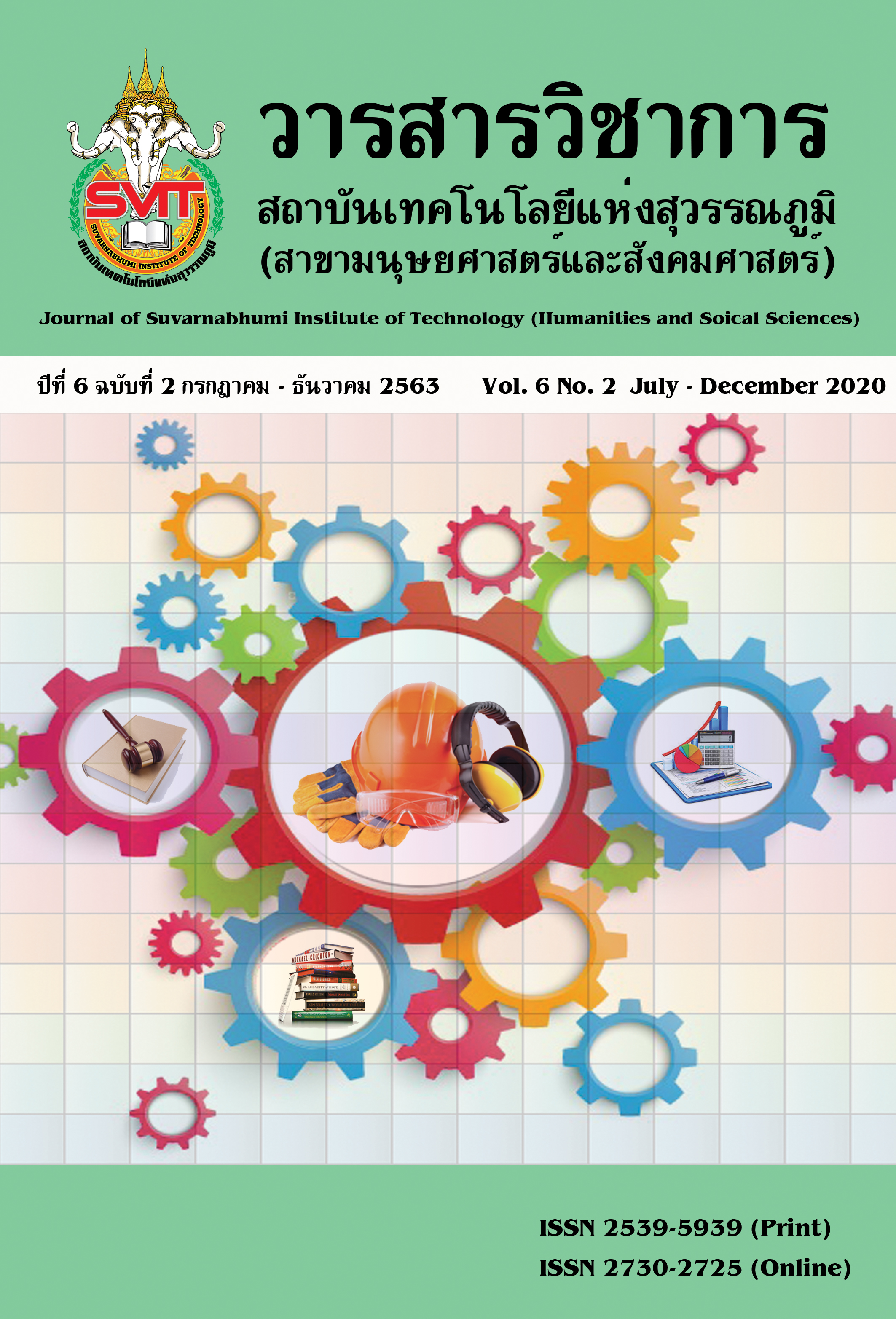THE CAUSAL FACTORS TOWA RD A QUALITY RELATIONSHIP AFFECTING THE SAVINGS BEHAVIOR FOR RETIREMENT A PROVIDENT FUND. CASE STUDY: EMPLOYEES OF SUSCO COMPANY LIMITED
Keywords:
Savings, Saving behavior, Provident fundAbstract
The purpose of this research was to study the causal factors toward quality relationship affecting the savings behavior for retirement through the provident fund of employees in private organizations through the provident fund of SUSCO Company Limited, which had 210 members. The researcher would select the population in SUSCO Co., Ltd. that have a saving in AIA Provident Fund from the age of 25 years and over. There were total of 145 sampling which was selected the sample group with the aim or purposive sampling. The statistics used for data analysis are as follows: 1. Descriptive Statistics Analysis: Frequency, Percentage and Mean 2. Analyzed by using Inferential Statistics (Chi-Square Test : X2- Test) to measure the relationship level by using Cramer's V statistics through the SPSS program.
The results of the study demonstrated that 1.) Personal factors that had a quality relationship affecting the savings behavior for retirement through the provident fund the highest was the working age, with the Cramer's V coefficient of 0.280, Sig value equal to 0.000. The number of family members had Cramer's V coefficient at 0.257. Sig value was equal to 0.004. Next, age and marital status have a Cramer's V coefficient of 0.243. Sig value was equal to 0.012. Next, education level had the value of Cramer ’S V at 0.204, Sig value of 0.237, and last, gender with Cramer’s V value at 0187, Sig value equal to 0.281. 2.) The economic factors that had a quality relationship affecting the savings behavior for retirement through the provident fund, the most was an average monthly income with Cramer's V coefficient at 0.369, Sig value equal to 0.000. Next, the return of the fund had the Cramer's V coefficient of 0.289 with Sig. Equal to 0.000 and the average monthly expense was Cramer's V At 0.239 with a Sig value of 0.007.
Therefore, economic factors that had a quality relationship affecting the savings behavior for retirement through the provident fund most. An average monthly income factor being the number one factor followed by the return of the fund, for personal factors, a quality relationship affecting the savings behavior for retirement through the provident fund are working age, followed by the number of family members.
References
กร ศิริโชควัฒนา. (2551). วิธีบริหารเงินของเศรษฐี ที่คนอยากรวยต้องเรียนรู้ (พิมพ์ครั้งที่ 1). กรุงเทพมหานคร: ยูแพดอินเตอร์.
กองทุนสำรองเลี้ยงชีพ เอไอ เอ. (ม.ป.ป.). สืบค้นเมื่อ 13 กุมภาพันธ์ 2558, จาก http://www.aia.co.th/th/ business/product-and-services/retirement-services/
กันยากร เอี่ยมแบน. (2561). การศึกษาช่องว่างการออมและการลงทุนที่มีผลต่อการเจริญเติบโตทางเศรษฐกิจ ของประเทศสมาชิกในกลุ่มอาเซียน. สืบค้นเมื่อ 18 พฤษภาคม 2561, จาก http://econ.nida.ac. th/index.php?option=com_content&view=article&id=3182%3A-mbe2558&catid=129% 3Astudent-independent-study&Itemid=207&lang=th
การเติบโตของกองทุนสำรองเลี้ยงชีพ. (ม.ป.ป.). สืบค้นเมื่อ 13 กุมภาพันธ์ 2558, จาก http://www.thaipvd. com/upload/pvd3q57.pdf
จุฑาธิบดิ์ ฤกษ์สันทัด. (2555). เปรียบเทียบพฤติกรรมการออมของพนักงานบริษัทเอกชนและข้าราชการในเขตกรุงเทพมหานคร (วิทยานิพนธ์ปริญญามหาบัณฑิต). มหาวิทยาลัยเทคโนโลยีราชมงคลธัญบุรี.
ธานินทร์ ศิลป์จารุ. (2550). การวิจัยและวิเคราะห์ข้อมูลด้วย SPSS (พิมพ์ครั้งที่ 7). กรุงเทพมหานคร:
วีอินเตอร์ปริ้น.
นวพร วิริยานุพงศ์. (2558). กองทุนการออมแห่งชาติ (กอช.): ความมั่นคงในชีวิต...สร้างได้ด้วยการออม. วารสารการเงินการคลัง, 27(85), 13-23.
นันทกา นันทวิสัย. (2552). การศึกษาเปรียบเทียบภาวการณ์ออมของครัวเรือนในภาคเกษตรและนอกภาค เกษตร (สารนิพนธ์ปริญญามหาบัณฑิต). มหาวิทยาลัยศรีนครินทรวิโรฒ.
ปัทมา ว่าพัฒนวงศ์, และปราโมทย์ ประสาทกุล. (2561). ประชากรไทยในอนาคต. สืบค้นเมื่อ 7 กุมภาพันธ์ 2561, จาก http://www.ipsr.mahidol.ac.th/IPSR/AnnualConference/ConferenceII/ Article /Article02.htm
วรากรณ์ สามโกเศศ. (2550). รู้จักใช้ เข้าใจเงิน (พิมพ์ครั้งที่ 2). กรุงเทพมหานคร: ธนาคารไทยพาณิชย์.
วิภพ เลาหเธียรประธาน. (2551). การศึกษาปัจจัยที่ส่งผลกระทบต่อการตัดสินใจลงทุนของนักลงทุนจากต่างประเทศ (สารนิพนธ์ปริญญามหาบัณฑิต). มหาวิทยาลัยหอการค้าไทย.
ศิรินุช อินละคร. (2548). การเงินบุคคล (พิมพ์ครั้งที่ 1). กรุงเทพมหานคร: สำนักพิมพ์มหาวิทยาลัย เกษตรศาสตร์.
ศิริอรุณ อนันตวิรุฬห์. (2550). พฤติกรรมการออมเพื่อการเตรียมเกษียณอายุของลูกจ้างสถานประกอบการเอกชนขนาดใหญ่ในกรุงเทพมหานคร (สารนิพนธ์ปริญญามหาบัณฑิต). มหาวิทยาลัยศรีนครินทรวิโรฒ
สถาบันวิจัยประชากรและสังคม. (2557). มอนิเตอร์ประเทศไทย. [ออนไลน์]
สันติยา เอกอัคร. (2549). เศรษฐศาสตร์การจัดการ ll. กรุงเทพมหานคร: สำนักพิมพ์มหาวิทยาลัย เกษตรศาสตร์.
สำนักงานคณะกรรมการพัฒนาเศรษฐกิจและสังคมแห่งชาติ 2560 กับ aging socity. (2560). สืบค้นเมื่อ 18 พฤษภาคม 2561, จาก http://www.nesdb.go.th/ewt_news.php?nid=6974&filename=index
อนิศา เซ็นนันท์. (2547). เงินทองของมีค่าช่วงชั้นที่ 4 (พิมพ์ครั้งที่ 2). กรุงเทพมหานคร: อมรินทร์พริ้นติ้งแอนด์พับลิชชิ่ง.
อมรรัตน์ อภินันท์มหกลุ. (2554). ความท้าทายและยั่งยืนของกองทุน การออมแห่งชาติ. วารสารเศรษฐศาสตร์และนโยบายสาธารณะ 2 มศว. ISSN 1906-8522
อัญชลี วสุนธราภิวัฒก์, และภาพร สูทกวาทิน. (2553). การศึกษาการออมและการลงทุนเพื่อการเกษียณอายุของข้าราชการที่เป็นสมาชิก กบข. โครงการวิจัยทุนสนับสนุนงานวิจัยของมหาวิทยาลัยเทคโนโลยีราชมงคลกรุงเทพ.งบประมาณผลประโยชน์, มหาวิทยาลัยเทคโนโลยีราชมงคลกรุงเทพ.
Alexander, C. (2001). Market Model, A Guide to Financial Date Analysis. John Wiley & Sons Ltd, USA.
Finnomena. (2017). ออมกี่เปอร์เซนต์ของรายได้. สืบค้นเมื่อ 14 ตุลาคม 2561,จาก https://www. finnomena.com/bearinvestor/how-much-savings/
Hamilton, J.D. (1994). Time Series Analysis, New Jersey, Princeton University Press. Retrieved May 18, 2561, from http://econ.nida.ac.th/index.php?option=com_content&view= article&id=3182%3A-mbe2558&catid=129%3Astudent-independent-study&Itemid=207&lang=th
Downloads
Published
Issue
Section
License
บทความที่ได้รับการตีพิมพ์เป็นลิขสิทธิ์ของวารสารวิชาการ สถาบันเทคโนโลยีแห่งสุวรรณภูมิ
ข้อความที่ปรากฏในบทความแต่ละเรื่องในวารสารวิชาการเล่มนี้เป็นความคิดเห็นส่วนตัวของผู้เขียนแต่ละท่านไม่เกี่ยวข้องกับสถาบันเทคโนโลยีแห่งสุวรรณภูมิ และคณาจารย์ท่านอื่นๆในสถาบันฯ แต่อย่างใด ความรับผิดชอบองค์ประกอบทั้งหมดของบทความแต่ละเรื่องเป็นของผู้เขียนแต่ละท่าน หากมีความผิดพลาดใดๆ ผู้เขียนแต่ละท่านจะรับผิดชอบบทความของตนเองแต่ผู้เดียว





